The Simpsons theme by Wurms
Download: Simpsons_by_Wurms.p3t
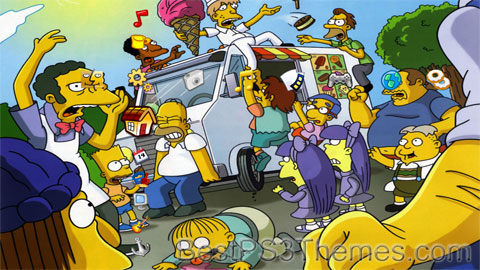
(9 backgrounds)
Redirect to:
This page is a redirect. The following categories are used to track and monitor this redirect:
|

The #1 spot for Playstation themes!
The Simpsons theme by Wurms
Download: Simpsons_by_Wurms.p3t

(9 backgrounds)
Redirect to:
This page is a redirect. The following categories are used to track and monitor this redirect:
|
Positively Upscale theme by jrtman
Download: p_upscale.p3t

(1 background)
P3T Unpacker v0.12
Copyright (c) 2007. Anoop Menon
This program unpacks Playstation 3 Theme files (.p3t) so that you can touch-up an existing theme to your likings or use a certain wallpaper from it (as many themes have multiple). But remember, if you use content from another theme and release it, be sure to give credit!
Download for Windows: p3textractor.zip
Instructions:
Download p3textractor.zip from above. Extract the files to a folder with a program such as WinZip or WinRAR. Now there are multiple ways to extract the theme.
The first way is to simply open the p3t file with p3textractor.exe. If you don’t know how to do this, right click the p3t file and select Open With. Alternatively, open the p3t file and it will ask you to select a program to open with. Click Browse and find p3textractor.exe from where you previously extracted it to. It will open CMD and extract the theme to extracted.[filename]. After that, all you need to do for any future p3t files is open them and it will extract.
The second way is very simple. Just drag the p3t file to p3textractor.exe. It will open CMD and extract the theme to extracted.[filename].
For the third way, first put the p3t file you want to extract into the same folder as p3textractor.exe. Open CMD and browse to the folder with p3extractor.exe. Enter the following:
p3textractor filename.p3t [destination path]Replace filename with the name of the p3t file, and replace [destination path] with the name of the folder you want the files to be extracted to. A destination path is not required. By default it will extract to extracted.filename.
Transformers theme by Christoforo
Download: Transformers.p3t
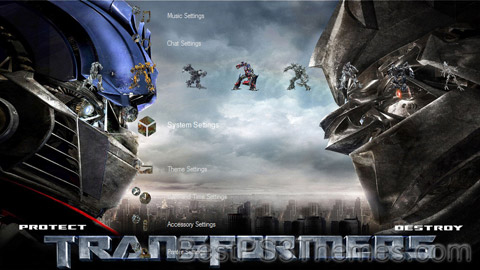
(1 background)
| Transformers | |
|---|---|
Franchise logo, 2014–present | |
| Created by | |
| Original work | Transformers (based on Diaclone and Micro Change) |
| Years | 1984–present |
| Print publications | |
| Book(s) | Complete list |
| Comics | Complete list |
| Films and television | |
| Film(s) | Animated |
| Animated series | Complete list |
| Games | |
| Video game(s) | Complete list |
| Audio | |
| Soundtrack(s) | Transformers audio releases |
| Miscellaneous | |
| Related franchises | |
Transformers is a media franchise produced by American toy company Hasbro and Japanese toy company Takara Tomy. It primarily follows the heroic Autobots and the villainous Decepticons, two alien robot factions at war that can transform into other forms, such as vehicles and animals. The franchise encompasses toys, animation, comic books, video games and films. As of 2011, it generated more than ¥2 trillion ($25 billion) in revenue,[1] making it one of the highest-grossing media franchises of all time.
The franchise began in 1984 with the Transformers toy line, comprising transforming mecha toys from Takara's Diaclone and Micro Change toylines rebranded for Western markets.[2] The term "Generation 1" covers both the animated television series The Transformers and the comic book series of the same name, which are further divided into Japanese, British and Canadian spin-offs, respectively. Sequels followed, such as the Generation 2 comic book and Beast Wars TV series, which became its own mini-universe. Generation 1 characters have been rebooted multiple times in the 21st century in comics from Dreamwave Productions (starting 2001), IDW Publishing (starting in 2005 and again in 2019), and Skybound Entertainment (beginning in 2023). There have been other incarnations of the story based on different toy lines during and after the 20th century. The first was the Robots in Disguise series, followed by three shows (Armada, Energon, and Cybertron) that constitute a single universe called the "Unicron Trilogy".
A live-action film series started in 2007, again distinct from previous incarnations, while the Transformers: Animated series merged concepts from the G1 continuity, the 2007 live-action film and the "Unicron Trilogy". For most of the 2010s, in an attempt to mitigate the wave of reboots, the "Aligned Continuity" was established. In 2018, Transformers: Cyberverse debuted, once again, distinct from the previous incarnations.
Although initially a separate and competing franchise started in 1983, Tonka's GoBots became the intellectual property of Hasbro after their buyout of Tonka in 1991. Subsequently, the universe depicted in the animated series Challenge of the GoBots and follow-up film GoBots: Battle of the Rock Lords was retroactively established as an alternate universe within the Transformers multiverse.[3]


Generation One is a retroactive term for the Transformers characters that appeared between 1984 and 1993. The Transformers began with the 1980s Japanese toy lines Micro Change and Diaclone. They presented robots able to transform into everyday vehicles, electronic items or weapons. Hasbro bought the Micro Change and Diaclone toys, and partnered with Takara.[4] Marvel Comics was hired by Hasbro to create the backstory; editor-in-chief Jim Shooter wrote an overall story, and gave the task of creating the characters to writer Dennis O'Neil.[5] Unhappy with O'Neil's work (although O'Neil created the name "Optimus Prime"), Shooter chose Bob Budiansky to create the characters.[6]
The Transformers mecha were largely designed by Shōji Kawamori, the creator of the Japanese mecha anime franchise Macross (which was adapted into the Robotech franchise in North America).[7] Kawamori came up with the idea of transforming mechs while working on the Diaclone and Macross franchises in the early 1980s (such as the VF-1 Valkyrie in Macross and Robotech), with his Diaclone mechs later providing the basis for Transformers.[8]
The primary concept of Generation One is that the heroic Optimus Prime, the villainous Megatron, and their finest soldiers crash-land on prehistoric Earth in the Ark and the Nemesis before awakening in 1985, Cybertron hurtling through the Neutral zone as an effect of the war. The Marvel comic was originally part of the main Marvel Universe, with appearances from Spider-Man and Nick Fury, plus some cameos,[9] as well as a visit to the Savage Land.[10]
The Transformers TV series began around the same time. Produced by Sunbow Productions and Marvel Productions, later Hasbro Productions, from the start it contradicted Budiansky's backstories. The TV series shows the Autobots looking for new energy sources, and crash landing as the Decepticons attack.[11] Marvel interpreted the Autobots as destroying a rogue asteroid approaching Cybertron.[12] Shockwave is loyal to Megatron on the TV series, keeping Cybertron in a stalemate during his absence,[13] but in the comic book, he attempts to take command of the Decepticons.[14] The TV series would also differ wildly from the origins Budiansky had created for the Dinobots,[15][16] the Decepticon turned Autobot Jetfire[17] (known as Skyfire on TV[18]), the Constructicons (who combine to form Devastator),[19][20] and Omega Supreme.[19][21] The Marvel comic establishes early on that Prime wields the Creation Matrix, which gives life to machines. In the second season, the two-part episode The Key to Vector Sigma introduced the ancient Vector Sigma computer, which served the same original purpose as the Creation Matrix (giving life to Transformers), and its guardian Alpha Trion.
In 1986, the cartoon became the film The Transformers: The Movie, which is set in the year 2005. It introduced the Matrix as the "Autobot Matrix of Leadership", as a fatally wounded Prime gives it to Ultra Magnus; however, as Prime dies he drops the matrix, which is then caught by Hot Rod who subsequently becomes Rodimus Prime later on in the film. Unicron, a Transformer who devours planets, fears its power and re-creates a heavily damaged Megatron as Galvatron, as well as Bombshell or Skywarp becoming Cyclonus, Thundercracker becoming Scourge and two other Insecticons becoming Scourge's huntsmen, the Sweeps. Eventually, Rodimus Prime takes out the Matrix and destroys Unicron.[22] In the United Kingdom, the weekly comic book interspliced original material to keep up with U.S. reprints,[23] and The Movie provided much new material. Writer Simon Furman proceeded to expand the continuity with movie spin-offs involving the time travelling Galvatron.[24][25] The Movie also featured guest voices from Leonard Nimoy as Galvatron, Scatman Crothers as Jazz, Casey Kasem as Cliffjumper, Orson Welles as Unicron and Eric Idle as the leader of the Junkions (Wreck-Gar, though unnamed in the movie). The Transformers theme tune for the film was performed by Lion with "Weird Al" Yankovic adding a song to the soundtrack.
The third season followed up The Movie, with the revelation of the Quintessons having used Cybertron as a factory. Their robots rebel, and in time the workers become the Autobots and the soldiers become the Decepticons. (Note: This appears to contradict background presented in the first two seasons of the series.) It is the Autobots who develop transformation.[26] Due to popular demand,[27] Optimus Prime is resurrected at the conclusion of the third season,[28] and the series ended with a three-episode story arc. However, the Japanese broadcast of the series was supplemented with a newly produced OVA, Scramble City, before creating entirely new series to continue the storyline, ignoring the 1987 end of the American series. The extended Japanese run consisted of The Headmasters, Super-God Masterforce, Victory and Zone, then in illustrated magazine form as Battlestars: Return of Convoy and Operation: Combination. Just as the TV series was wrapping up, Marvel continued to expand its continuity. It follows The Movie's example by killing Prime[29] and Megatron,[30] albeit in the present day. Dinobot leader Grimlock takes over as Autobot leader.[31] There was a G.I. Joe crossover[32] and the limited series The Transformers: Headmasters, which further expanded the scope to the planet Nebulon.[33] It led on to the main title resurrecting Prime as a Powermaster.[34]
In the United Kingdom, the mythology continued to grow. Primus is introduced as the creator of the Transformers, to serve his material body that is planet Cybertron and fight his nemesis Unicron.[35] Female Autobot Arcee also appeared, despite the comic book stating the Transformers had no concept of gender, with her backstory of being built by the Autobots to quell human accusations of sexism.[36] Soundwave, Megatron's second-in-command, also breaks the fourth wall in the letters page, criticising the cartoon continuity as an inaccurate representation of history.[37] The UK also had a crossover in Action Force, the UK counterpart to G.I. Joe.[38] The comic book features a resurrected Megatron,[39] whom Furman retconned to be a clone[40] when he took over the U.S. comic book, which depicted Megatron as still dead.[41] The U.S. comic would last for 80 issues until 1991,[42] and the UK comic lasted 332 issues and several annuals, until it was replaced as Dreamwave Productions, later in the 20th-Century.
In 2009, Shout! Factory released the entire G1 series in a 16-DVD box set called the Matrix of Leadership Edition.[43] They also released the same content as individual seasons.[44]
It was five issues[45] of the G.I. Joe comic in 1993 that would springboard a return for Marvel's Transformers, with the new twelve-issue series Transformers: Generation 2, to market a new toy line.
This story reveals that the Transformers originally breed asexually, though it is stopped by Primus because it produced the evil Swarm.[46] A new empire, neither Autobot nor Decepticon, is bringing it back, however. Though the year-long arc wrapped itself up with an alliance between Optimus Prime and Megatron, the final panel introduces the Liege Maximo, ancestor of the Decepticons.[47] This minor cliffhanger was not resolved until 2001 and 2002's Transforce convention when writer Simon Furman concluded his story in the exclusive novella Alignment.[48]
The story focuses on a small group of Maximals (the new Autobots), led by Optimus Primal, and Predacons, led by Megatron, 300 years after the "Great War". After a dangerous pursuit through transwarp space, both the Maximal and Predacon factions end up crash landing on a primitive, uncivilized planet similar to Earth, but with two moons and a dangerous level of Energon (which is later revealed to be prehistoric Earth with an artificial second moon, taking place sometime during the 4 million year period in which the Autobots and Decepticons were in suspended animation from the first episode of the original Transformers cartoon), which forces them to take organic beast forms in order to function without going into stasis lock.[49] After writing this first episode, Bob Forward and Larry DiTillio learned of the G1 Transformers and began to use elements of it as a historical backstory to their scripts,[50] establishing Beast Wars as a part of the Generation 1 universe through numerous callbacks to both the cartoon and the Marvel comic. By the end of the first season, the second moon and the Energon are revealed to have been constructed by a mysterious alien race known as the Vok.

The destruction of the second moon releases mysterious energies that make some of the characters "transmetal" and the planet is revealed to be prehistoric Earth, leading to the discovery of the Ark. Megatron attempts to kill the original Optimus Prime,[51] but at the beginning of the third season, Primal manages to preserve his spark. In the two-season follow-up series, Beast Machines, Cybertron is revealed to have organic origins, which Megatron attempts to stamp out.
After the first season of Beast Wars (comprising 26 episodes) aired in Japan, the Japanese were faced with a problem. The second Canadian season was only 13 episodes long, not enough to warrant airing on Japanese TV. While they waited for the third Canadian season to be completed (thereby making 26 episodes in total when added to season 2), they produced two exclusive cel-animated series of their own, Beast Wars II (also called Beast Wars Second) and Beast Wars Neo, to fill in the gap. Dreamwave retroactively revealed Beast Wars to be the future of their G1 universe,[52] and the 2006 IDW comic book Beast Wars: The Gathering eventually confirmed the Japanese series to be canon[53] within a story set during Season 3.[54]
Beast Wars contained elements from both the G1 cartoon series and comics. Attributes taken from the cartoon include Transformers that were female, the appearance of Starscream (who mentions being killed off by Galvatron in The Transformers: The Movie), and appearances of the Plasma Energy Chamber and Key to Vector Sigma. The naming of the Transformer ship, the Ark (and reference to 1984, the year the Transformers on board are revived), the character Ravage being shown as intelligent, and Cybertron having an organic core are elements taken from the comics.
In 2011, Shout! Factory released the complete series of Beast Wars on DVD.[55]
In 2001, Dreamwave Productions began a new universe of annual comics adapted from Marvel, but also included elements of the animated. The Dreamwave stories followe the concept of the Autobots defeating the Decepticons on Earth, but their 1997 return journey to Cybertron on the Ark II[56] is destroyed by Shockwave, now ruler of the planet.[57] The story follows on from there and was told in two six-issue limited series, then a ten-issue ongoing series. The series also adds extra complexities such as not all Transformers believing in the existence of Primus,[58] corruption in the Cybertronian government that first led Megatron to begin his war,[59] and Earth having an unknown relevance to Cybertron.[57][60]
Three Transformers: The War Within limited series were also published. These are set at the beginning of the Great War, and identify Prime as once being a clerk named Optronix.[61] Beast Wars was also retroactively stated as the future of this continuity, with the profile series More than Meets the Eye showing the Predacon Megatron looking at historical files detailing Dreamwave's characters and taking his name from the original Megatron.[52] In 2004, this real life universe also inspired three novels[62] and a Dorling Kindersley guide, which focused on Dreamwave as the "true" continuity when discussing in-universe elements of the characters. In a new twist, Primus and Unicron are siblings, formerly a being known as the One. Transformers: Micromasters, set after the Ark's disappearance, was also published. The real life universe was disrupted when Dreamwave went bankrupt in 2005.[63] This left the Generation One story hanging and the third volume of The War Within half finished. Plans for a comic book set between Beast Wars and Beast Machines were also left unrealized.[64]
Throughout the years, the G1 characters have also starred in crossovers with fellow Hasbro property G.I. Joe, but whereas those crossovers published by Marvel were in continuity with their larger storyline, those released by Dreamwave and G.I. Joe publisher Devil's Due Publishing occupy their own separate real life universes. In Devil's Due, the terrorist organization Cobra is responsible for finding and reactivating the Transformers. Dreamwave's version reimagines the familiar G1 and G.I. Joe characters in a World War II setting, and a second limited series was released set in the present day, though Dreamwave's bankruptcy meant it was cancelled after a single issue. Devil's Due had Cobra re-engineer the Transformers to turn into familiar Cobra vehicles, and released further mini-series that sent the characters travelling through time, battling Serpentor and being faced with the combined menace of Cobra-La and Unicron. During this time, Cobra teams up with the Decepticons. IDW Publishing has expressed interest in their own crossover.[65]
The following year, IDW Publishing rebooted the G1 series from scratch within various limited series and one shots. This allowed long-time writer of Marvel and Dreamwave comics, Simon Furman to create his own universe without continuity hindrance, similar to Ultimate Marvel. This new continuity originally consisted of a comic book series titled The Transformers with a companion series known as The Transformers: Spotlight. The main series was broken up into several story arcs. Eventually, with IDW Publishing losing sales, the series was given a soft reboot. Beginning with All Hail Megatron, the series was set in a new direction, discarding the miniseries and Spotlight format with ongoing comics. By 2012 the series had split into three ongoing series; The Transformers: More Than Meets The Eye, The Transformers: Robots in Disguise (which later changed in 2015 to "The Transformers") and The Transformers: Till All Are One. In 2022, it was announced that IDW lost the publishing rights to Transformers.[66]
In January 2006, the Hasbro Transformers Collectors' Club comic wrote a story based on the Transformers Classics toy line, set in the Marvel Comics universe, but excluding the Generation 2 comic. Fifteen years after Megatron crash-lands in the Ark with Ratchet, the war continues with the characters in their Classics bodies.[67]
IDW Publishing introduced The Transformers: Evolutions in 2006, a collection of mini-series that re-imagine and reinterpret the G1 characters in various ways. To date, only one miniseries has been published, Hearts of Steel, placing the characters in an Industrial Revolution-era setting. The series was delayed as Hasbro did not want to confuse newcomers with too many fictional universes before the release of the live-action film.[68]
However, IDW and the original publisher Marvel Comics announced a crossover storyline with the Avengers to coincide with the film New Avengers/Transformers.[69] The story is set on the borders of Symkaria and Latveria, and its fictional universe is set between the first two New Avengers storylines, as well in between the Infiltration and Escalation phase of IDW's The Transformers.[70] IDW editor-in-chief, Chris Ryall hinted at elements of it being carried over into the main continuities,[71] and that a sequel is possible.[72] In June 2018 it was announced there would be Star Trek and Transformers Crossover being released in September 2018.[73]
Transformers: Kiss Players (トランスフォーマー キスぷれ, Toransufōmā Kisu Pure), shortened to Kiss Players (キスぷれ, Kisu Pure), is a Japanese Transformers franchise which began in 2006 to 2007 as was helmed by artist and writer Yuki Ohshima. By virtue of being the only Transformers toyline and fiction released in Japan by Takara between the conclusion of Cybertron and the live-acti
Family Guy theme by The_Rick_14
Download: FamilyGuy.p3t

(1 background)
| Family Guy | |
|---|---|
 | |
| Genre | Animated sitcom[1] |
| Created by | Seth MacFarlane |
| Developed by |
|
| Showrunners |
|
| Voices of |
|
| Theme music composer | Walter Murphy |
| Composers |
|
| Country of origin | United States |
| Original language | English |
| No. of seasons | 22 |
| No. of episodes | 424 (list of episodes) |
| Production | |
| Executive producers |
|
| Producers |
|
| Running time |
|
| Production companies |
|
| Original release | |
| Network | Fox[N 1] |
| Release | January 31, 1999 – February 14, 2002[2][c] |
| Release | May 1, 2005[2] – present |
| Related | |
Family Guy is an American animated sitcom created by Seth MacFarlane for the Fox Broadcasting Company. The series premiered on January 31, 1999, following Super Bowl XXXIII, with the rest of the first season airing from April 11, 1999. The show centers around the Griffins, a dysfunctional family consisting of parents Peter and Lois, their children, Meg, Chris, and Stewie, and their anthropomorphic pet dog, Brian. Set in the fictional city of Quahog, Rhode Island, the show exhibits much of its humor in the form of metafictional cutaway gags that often lampoon American culture.
The family was conceived by MacFarlane after he developed two animated films, The Life of Larry and Larry & Steve. MacFarlane redesigned the films' protagonist, Larry, and his dog, Steve, and renamed them Peter and Brian, respectively. MacFarlane pitched a seven-minute pilot to Fox in December 1998, and the show was greenlit and began production. Family Guy's cancellation was announced shortly after the third season had aired in 2002, with one unaired episode eventually premiering on Adult Swim in 2003, finishing the series' original run. Favorable DVD sales and high ratings from syndicated reruns since then convinced Fox to revive the show in 2004; a fourth season began airing the following year, on May 1, 2005.
Since its premiere, Family Guy has received generally positive reviews. In 2009, it was nominated for a Primetime Emmy Award for Outstanding Comedy Series, the first time an animated series had been nominated for the award since The Flintstones in 1961. In 2013, TV Guide ranked Family Guy as the ninth-greatest TV cartoon.[3] Although highly satirical in nature, the series has also garnered considerable amounts of criticism and controversy, ranging from storylines and character stereotypes, to allegations of racism, homophobia, and sexism.
Many tie-in media based on the show have been released, including Stewie Griffin: The Untold Story, a straight-to-DVD special released in 2005; Family Guy: Live in Vegas, a soundtrack-DVD combo released in 2005, featuring music from the show as well as music created by MacFarlane and Walter Murphy; a video game and pinball machine, released in 2006 and 2007, respectively; since 2005, six books published by Harper Adult; and Laugh It Up, Fuzzball: The Family Guy Trilogy (2010), a collection of three episodes parodying the original Star Wars trilogy. A spin-off series, The Cleveland Show, featuring Cleveland Brown, aired from September 27, 2009, to May 19, 2013.
On January 26, 2023, Fox announced that the series had been renewed for seasons 22 and 23, taking the show through the 2024–25 television season.[4] Season 22 premiered on October 1, 2023.[5] Family Guy moved to Wednesday nights beginning March 6, 2024, marking the first time the show airs on a weeknight since 2002.[6]

The show centers around the adventures and activities of the dysfunctional Griffin family, consisting of father Peter Griffin, a bumbling and clumsy yet well-intentioned blue-collar worker; his wife Lois, a stay-at-home mother and piano teacher (in early episodes) who is a member of the affluent Pewterschmidt family; Meg, their often bullied teenage daughter who is constantly ridiculed or ignored by the family; Chris, their awkward teenage son, who is overweight, unintelligent, unathletic, and in many respects a younger version of his father; and Stewie, their diabolical infant son of ambiguous sexual orientation who is an adult-mannered evil genius and uses stereotypical archvillain phrases. Living with the family is their witty, smoking, martini-swilling, sarcastic, English-speaking anthropomorphic dog Brian, although he is still considered a pet in many ways.[7]
Recurring characters appear alongside the Griffin family. These include the family's neighbors: sex-crazed airline pilot bachelor Glenn Quagmire; deli owner/mail carrier Cleveland Brown and his wife Loretta (later Donna); paraplegic police officer Joe Swanson, his wife Bonnie, their son Kevin and their baby daughter Susie; neurotic Jewish pharmacist Mort Goldman, his wife Muriel, and their geeky and annoying son Neil, and elderly child molester Herbert. TV news anchors Tom Tucker and Diane Simmons, Asian reporter Tricia Takanawa, and Blaccu-Weather meteorologist Ollie Williams also make frequent appearances. Actor James Woods guest stars as himself in multiple episodes, as did Adam West, prior to his death.[citation needed]
The primary setting of Family Guy is Quahog (/ˈk(w)oʊhɒɡ/ K(W)OH-hog), a fictional city in Rhode Island that was founded by Peter's ancestor, Griffin Peterson. MacFarlane resided in Providence during his time as a student at Rhode Island School of Design, and the show contains distinct Rhode Island landmarks similar to real-world locations.[8][9] MacFarlane often borrows the names of Rhode Island locations and icons such as Pawtucket and Buddy Cianci for use in the show. MacFarlane, in an interview with Providence's Fox affiliate WNAC-TV, stated that the town is modeled after Cranston, Rhode Island.[10]
| Season | Episodes | Originally aired | Rank | Average Viewers (in millions) | ||
|---|---|---|---|---|---|---|
| First aired | Last aired | |||||
| 1 | 7 | January 31, 1999 | May 16, 1999 | 33 | 14.12[11] | |
| 2 | 21 | September 23, 1999 | August 1, 2000 | 114 | 6.74 | |
| 3 | 22 | July 11, 2001 | November 9, 2003[d] | 125 | 5.61[12] | |
| 4 | 30 | May 1, 2005 | May 21, 2006 | 68 | 7.90[13] | |
| 5 | 18 | September 10, 2006 | May 20, 2007 | 71 | 7.20[14] | |
| 6 | 12 | September 23, 2007 | May 4, 2008 | 84 | 7.94[15] | |
| 7 | 16 | September 28, 2008 | May 17, 2009 | 69 | 7.46[16] | |
| 8 | 21 | September 27, 2009 | June 20, 2010[e] | 53 | 7.13[17] | |
| 9 | 18 | September 26, 2010 | May 22, 2011 | 56 | 6.78[18] | |
| 10 | 23 | September 25, 2011 | May 20, 2012 | 63 | 5.65[19] | |
| 11 | 22 | September 30, 2012 | May 19, 2013 | 62 | 5.39[20] | |
| 12 | 21 | September 29, 2013 | May 18, 2014 | 78 | 4.65[21] | |
| 13 | 18 | September 28, 2014 | May 17, 2015 | 94 | 3.84[22] | |
| 14 | 20 | September 27, 2015 | May 22, 2016 | 111 | 3.09[23] | |
| 15 | 20 | September 25, 2016 | May 21, 2017 | 116 | 2.76[24] | |
| 16 | 20 | October 1, 2017 | May 20, 2018 | 136 | 2.54[25] | |
| 17 | 20 | September 30, 2018 | May 12, 2019 | 131 | 2.35[26] | |
| 18 | 20 | September 29, 2019 | May 17, 2020 | 107[27] | 1.80[27] | |
| 19 | 20 | September 27, 2020 | May 16, 2021 | 120[28] | 1.55[28] | |
| 20 | 20 | September 26, 2021 | May 22, 2022 | 111[29] | 1.25[29] | |
| 21 | 20 | September 25, 2022 | May 7, 2023 | 104[30] | 1.19[30] | |
| 22 | 15 | October 1, 2023 | April 17, 2024 | 115[31] | 1.03[31] | |
MacFarlane conceived Family Guy in 1995 while studying animation at the Rhode Island School of Design (RISD).[32] During college, he created his thesis film titled The Life of Larry,[32] which was submitted by his professor at RISD to Hanna-Barbera. MacFarlane was hired by the company.[33] In 1996, MacFarlane created a sequel to The Life of Larry titled Larry and Steve, which featured a middle-aged character named Larry and an intellectual dog, Steve; the short was broadcast in 1997 as one of Cartoon Network's World Premiere Toons.[32]
Executives at Fox saw the Larry shorts and contracted MacFarlane to create a series, titled Family Guy, based on the characters.[9] Fox proposed that MacFarlane complete a 15-minute short and gave him a budget of $50,000.[34] Several aspects of Family Guy were inspired by the Larry shorts.[35] While MacFarlane worked on the series, the characters of Larry and his dog Steve slowly evolved into Peter and Brian.[9][36] MacFarlane stated that the difference between The Life of Larry and Family Guy was that "Life of Larry was shown primarily in my dorm room and Family Guy was shown after the Super Bowl."[35] After the pilot aired, the series was given the greenlight. MacFarlane drew inspiration from several sitcoms such as The Simpsons and All in the Family.[37] Premises were drawn from several 1980s Saturday-morning cartoons he watched as a child, such as The Fonz and the Happy Days Gang and Rubik, the Amazing Cube.[38]
The Griffin family first appeared on the demo that MacFarlane pitched to Fox on May 15, 1998.[39] Family Guy was originally planned to start out as short movies for the sketch show Mad TV, but the plan changed, because MADtv's budget was not large enough to support animation production. MacFarlane noted that he then wanted to pitch it to Fox, as he thought that it was the place to create a prime-time animation show.[37] Family Guy was originally pitched to Fox in the same year as King of the Hill, but
Kubrick Tribute theme by YASAI
Download: KubrickTribute.p3t

(1 background)
P3T Unpacker v0.12
Copyright (c) 2007. Anoop Menon
This program unpacks Playstation 3 Theme files (.p3t) so that you can touch-up an existing theme to your likings or use a certain wallpaper from it (as many themes have multiple). But remember, if you use content from another theme and release it, be sure to give credit!
Download for Windows: p3textractor.zip
Instructions:
Download p3textractor.zip from above. Extract the files to a folder with a program such as WinZip or WinRAR. Now there are multiple ways to extract the theme.
The first way is to simply open the p3t file with p3textractor.exe. If you don’t know how to do this, right click the p3t file and select Open With. Alternatively, open the p3t file and it will ask you to select a program to open with. Click Browse and find p3textractor.exe from where you previously extracted it to. It will open CMD and extract the theme to extracted.[filename]. After that, all you need to do for any future p3t files is open them and it will extract.
The second way is very simple. Just drag the p3t file to p3textractor.exe. It will open CMD and extract the theme to extracted.[filename].
For the third way, first put the p3t file you want to extract into the same folder as p3textractor.exe. Open CMD and browse to the folder with p3extractor.exe. Enter the following:
p3textractor filename.p3t [destination path]Replace filename with the name of the p3t file, and replace [destination path] with the name of the folder you want the files to be extracted to. A destination path is not required. By default it will extract to extracted.filename.
Star Wars Vader Time theme by PenguinRage and EVILEMPIRE
Download: VaderTime_by_PenguinRage.p3t

(1 background)
P3T Unpacker v0.12
Copyright (c) 2007. Anoop Menon
This program unpacks Playstation 3 Theme files (.p3t) so that you can touch-up an existing theme to your likings or use a certain wallpaper from it (as many themes have multiple). But remember, if you use content from another theme and release it, be sure to give credit!
Download for Windows: p3textractor.zip
Instructions:
Download p3textractor.zip from above. Extract the files to a folder with a program such as WinZip or WinRAR. Now there are multiple ways to extract the theme.
The first way is to simply open the p3t file with p3textractor.exe. If you don’t know how to do this, right click the p3t file and select Open With. Alternatively, open the p3t file and it will ask you to select a program to open with. Click Browse and find p3textractor.exe from where you previously extracted it to. It will open CMD and extract the theme to extracted.[filename]. After that, all you need to do for any future p3t files is open them and it will extract.
The second way is very simple. Just drag the p3t file to p3textractor.exe. It will open CMD and extract the theme to extracted.[filename].
For the third way, first put the p3t file you want to extract into the same folder as p3textractor.exe. Open CMD and browse to the folder with p3extractor.exe. Enter the following:
p3textractor filename.p3t [destination path]Replace filename with the name of the p3t file, and replace [destination path] with the name of the folder you want the files to be extracted to. A destination path is not required. By default it will extract to extracted.filename.
Spiderman Black theme by mikeyrawr
Download: SpidermanBlack.p3t
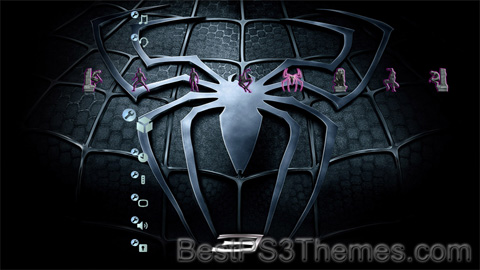
(1 background)
P3T Unpacker v0.12
Copyright (c) 2007. Anoop Menon
This program unpacks Playstation 3 Theme files (.p3t) so that you can touch-up an existing theme to your likings or use a certain wallpaper from it (as many themes have multiple). But remember, if you use content from another theme and release it, be sure to give credit!
Download for Windows: p3textractor.zip
Instructions:
Download p3textractor.zip from above. Extract the files to a folder with a program such as WinZip or WinRAR. Now there are multiple ways to extract the theme.
The first way is to simply open the p3t file with p3textractor.exe. If you don’t know how to do this, right click the p3t file and select Open With. Alternatively, open the p3t file and it will ask you to select a program to open with. Click Browse and find p3textractor.exe from where you previously extracted it to. It will open CMD and extract the theme to extracted.[filename]. After that, all you need to do for any future p3t files is open them and it will extract.
The second way is very simple. Just drag the p3t file to p3textractor.exe. It will open CMD and extract the theme to extracted.[filename].
For the third way, first put the p3t file you want to extract into the same folder as p3textractor.exe. Open CMD and browse to the folder with p3extractor.exe. Enter the following:
p3textractor filename.p3t [destination path]Replace filename with the name of the p3t file, and replace [destination path] with the name of the folder you want the files to be extracted to. A destination path is not required. By default it will extract to extracted.filename.
Star Wars Troopers theme by olapbill
Download: StarWarsTroopers.p3t
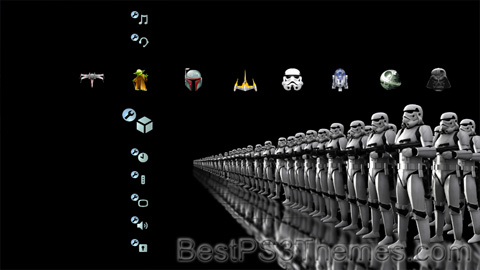
(2 backgrounds)
P3T Unpacker v0.12
Copyright (c) 2007. Anoop Menon
This program unpacks Playstation 3 Theme files (.p3t) so that you can touch-up an existing theme to your likings or use a certain wallpaper from it (as many themes have multiple). But remember, if you use content from another theme and release it, be sure to give credit!
Download for Windows: p3textractor.zip
Instructions:
Download p3textractor.zip from above. Extract the files to a folder with a program such as WinZip or WinRAR. Now there are multiple ways to extract the theme.
The first way is to simply open the p3t file with p3textractor.exe. If you don’t know how to do this, right click the p3t file and select Open With. Alternatively, open the p3t file and it will ask you to select a program to open with. Click Browse and find p3textractor.exe from where you previously extracted it to. It will open CMD and extract the theme to extracted.[filename]. After that, all you need to do for any future p3t files is open them and it will extract.
The second way is very simple. Just drag the p3t file to p3textractor.exe. It will open CMD and extract the theme to extracted.[filename].
For the third way, first put the p3t file you want to extract into the same folder as p3textractor.exe. Open CMD and browse to the folder with p3extractor.exe. Enter the following:
p3textractor filename.p3t [destination path]Replace filename with the name of the p3t file, and replace [destination path] with the name of the folder you want the files to be extracted to. A destination path is not required. By default it will extract to extracted.filename.
The Simpsons theme by borrer0
Download: TheSimpsons_2.p3t
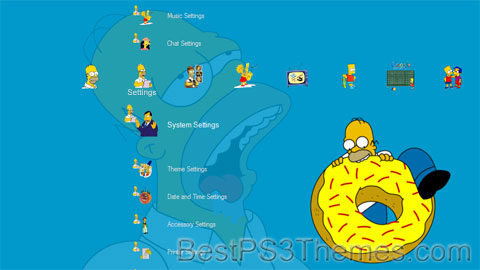
(13 backgrounds)
| The Simpsons | |
|---|---|
 | |
| Genre | |
| Created by | Matt Groening |
| Based on | The Simpsons shorts by Matt Groening |
| Developed by |
|
| Showrunners |
|
| Voices of | |
| Theme music composer | Danny Elfman |
| Opening theme | "The Simpsons Theme" |
| Ending theme | "The Simpsons Theme" (reprise) |
| Composers | Richard Gibbs (1989–1990) Alf Clausen (1990–2017) Bleeding Fingers Music (2017–present) |
| Country of origin | United States |
| Original language | English |
| No. of seasons | 35 |
| No. of episodes | 768 (list of episodes) |
| Production | |
| Executive producers | List
|
| Producers |
|
| Editors |
|
| Running time | 21–24 minutes |
| Production companies |
|
| Original release | |
| Network | Fox |
| Release | December 17, 1989 – present |
The Simpsons is an American animated sitcom created by Matt Groening for the Fox Broadcasting Company.[1][2][3] Developed by Groening, James L. Brooks, and Sam Simon, the series is a satirical depiction of American life, epitomized by the Simpson family, which consists of Homer, Marge, Bart, Lisa, and Maggie. Set in the fictional town of Springfield, it caricatures society, Western culture, television, and the human condition.
The family was conceived by Groening shortly before a solicitation for a series of animated shorts with producer Brooks. He created a dysfunctional family and named the characters after his own family members, substituting Bart for his own name; he thought Simpson was a funny name in that it sounded similar to "simpleton".[4] The shorts became a part of The Tracey Ullman Show on April 19, 1987. After three seasons, the sketch was developed into a half-hour prime time show and became Fox's first series to land in the Top 30 ratings in a season (1989–1990).
Since its debut on December 17, 1989, 768 episodes of the show have been broadcast. It is the longest-running American animated series, longest-running American sitcom, and the longest-running American scripted primetime television series, both in seasons and individual episodes. A feature-length film, The Simpsons Movie, was released in theaters worldwide on July 27, 2007, to critical and commercial success, with a sequel in development as of 2018. The series has also spawned numerous comic book series, video games, books, and other related media, as well as a billion-dollar merchandising industry. The Simpsons is a joint production by Gracie Films and 20th Television.[5]
On January 26, 2023, the series was renewed for its 35th and 36th seasons, taking the show through the 2024–25 television season.[6] Both seasons contain a combined total of 51 episodes. Seven of these episodes are season 34 holdovers, while the other 44 will be produced in the production cycle of the upcoming seasons, bringing the show's overall episode total up to 801.[7] Season 35 premiered on October 1, 2023.[8]
The Simpsons received widespread acclaim throughout its early seasons in the 1990s, which are generally considered its "golden age". Since then, it has been criticized for a perceived decline in quality. Time named it the 20th century's best television series,[9] and Erik Adams of The A.V. Club named it "television's crowning achievement regardless of format".[10] On January 14, 2000, the Simpson family was awarded a star on the Hollywood Walk of Fame. It has won dozens of awards since it debuted as a series, including 37 Primetime Emmy Awards, 34 Annie Awards, and 2 Peabody Awards. Homer's exclamatory catchphrase of "D'oh!" has been adopted into the English language, while The Simpsons has influenced many other later adult-oriented animated sitcom television series.
The main characters are the Simpson family, who live in the fictional "Middle America" town of Springfield.[11] Homer, the father, works as a safety inspector at the Springfield Nuclear Power Plant, a position at odds with his careless, buffoonish personality. He is married to Marge (née Bouvier), a stereotypical American housewife and mother. They have three children: Bart, a ten-year-old troublemaker and prankster; Lisa, a precocious eight-year-old activist; and Maggie, the baby of the family who rarely speaks, but communicates by sucking on a pacifier. Although the family is dysfunctional, many episodes examine their relationships and bonds with each other and they are often shown to care about one another.[12]
The family also owns a greyhound, Santa's Little Helper, (who first appeared in the episode "Simpsons Roasting on an Open Fire" and a cat, Snowball II, who is replaced by a cat also called Snowball II in the fifteenth-season episode "I, (Annoyed Grunt)-Bot".[13] Extended members of the Simpson and Bouvier family in the main cast include Homer's father Abe and Marge's sisters Patty and Selma. Marge's mother Jacqueline and Homer's mother Mona appear less frequently.
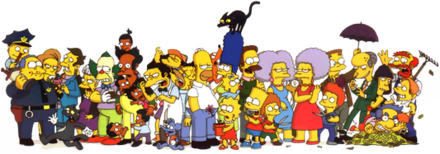
The show includes a vast array of quirky supporting characters, which include Homer's friends Barney Gumble, Lenny Leonard and Carl Carlson; the school principal Seymour Skinner and staff members such as Edna Krabappel and Groundskeeper Willie; students such as Milhouse Van Houten, Nelson Muntz and Ralph Wiggum; shopkeepers such as Apu Nahasapeemapetilon, Comic Book Guy and Moe Szyslak; government figures Mayor "Diamond" Joe Quimby and Clancy Wiggum; next-door neighbor Ned Flanders; local celebrities such as Krusty the Clown and news reporter Kent Brockman; nuclear tycoon Montgomery Burns and his devoted assistant Waylon Smithers; and dozens more.
The creators originally intended many of these characters as one-time jokes or for fulfilling needed functions in the town. A number of them have gained expanded roles and subsequently starred in their own episodes. According to Matt Groening, the show adopted the concept of a large supporting cast from the comedy show SCTV.[14]
Despite the depiction of yearly milestones such as holidays or birthdays passing, the characters never age. The series uses a floating timeline in which episodes generally take place in the year the episode is produced. Flashbacks and flashforwards do occasionally depict the characters at other points in their lives, with the timeline of these depictions also generally floating relative to the year the episode is produced. For example, the 1991 episodes "The Way We Was" and "I Married Marge" depict Homer and Marge as high schoolers in the 1970s who had Bart (who is always 10 years old) in the early '80s, while the 2008 episode "That '90s Show" depicts Homer and Marge as a childless couple in the '90s, and the 2021 episode "Do Pizza Bots Dream of Electric Guitars" portrays Homer as an adolescent in the same period. The 1995 episode "Lisa's Wedding" takes place during Lisa's college years in the then-future year of 2010, the same year the show began airing its 22nd season, in which Lisa was still 8. Regarding the contradictory flashbacks, Selman stated that "they all kind of happened in their imaginary world."[15]
The show follows a loose and inconsistent continuity. For example, Krusty the Clown may be able to read in one episode, but not in another. However, it is consistently portrayed that he is Jewish, that his father was a rabbi, and that his career began in the 1960s. The latter point introduces another snag in the floating timeline: historical periods that are a core part of a character's backstory remain so even when their age makes it unlikely or impossible, such as Grampa Simpson and Principal Skinner's respective service in World War II and Vietnam.
The only episodes not part of the series' main canon are the Treehouse of Horror episodes, which often feature the deaths of main characters. Characters who die in "regular" episodes, such as Maude Flanders, Mona Simpson and Edna Krabappel, however, stay dead. Most episodes end with the status quo being restored, though occasionally major changes will stick, such as Lisa's conversions to vegetarianism and Buddhism, the divorce of Milhouse van Houten's parents, and the marriage and subsequent parenthood of Apu and Manjula.
The Simpsons takes place in a fictional American town called Springfield. Although there are many real settlements in America named Springfield,[16] the town the show is set in is fictional. The state it is in is not established. In fact, the show is intentionally evasive with regard to Springfield's location.[17] Springfield's geography and that of its surroundings is inconsistent: from one episode to another, it may have coastlines, deserts, vast farmland, mountains, or whatever the story or joke requires.[18] Groening has said that Springfield has much in common with Portland, Oregon, the city where he grew up.[19] Groening has said that he named it after Springfield, Oregon, and the fictitious Springfield which was the setting of the series Father Knows Best. He "figured out that Springfield was one of the most common names for a city in the U.S. In anticipation of the success of the show, I thought, 'This will be cool; everyone will think it's their Springfield.' And they do."[20] Many landmarks, including street names, have connections to Portland.[21]
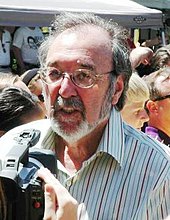
When producer James L. Brooks was working on the television variety show The Tracey Ullman Show, he decided to include small animated sketches before and after the commercial breaks. Having seen one of cartoonist Matt Groening's Life in Hell comic strips, Brooks asked Groening to pitch an idea for a series of animated shorts. Groening initially intended to present an animated version of his Life in Hell series.[22] However, Groening later realized that animating Life in Hell would require the rescinding of publication rights for his life's work. He therefore chose another approach while waiting in the lobby of Brooks's office for the pitch meeting, hurriedly formulating his version of a dysfunctional family that became the Simpsons.[22][23] He named the characters after his own family members, substituting "Bart" for his own name, adopting an anagram of the word brat.[22]
The Simpson family first appeared as shorts in The Tracey Ullman Show on April 19, 1987.[24] Groening submitted only basic sketches to the animators and assumed that the figures would be cleaned up in production. However, the animators merely re-traced his drawings, which led to the crude appearance of the characters in the initial shorts.[22] The animation was produced domestically at Klasky Csupo,[25][26] with Wes Archer, David Silverman, and Bill Kopp being animators for the first season.[27] The colorist, "Georgie" Gyorgyi Kovacs Peluce (Kovács Györgyike)[28][29][30][31][32][33] made the characters yellow; as Bart, Lisa and Maggie have no hairlines, she felt they would look strange if they were flesh-colored. Groening supported the decision, saying: "Marge is yellow with blue hair? That's hilarious — let's do it!"[27]
In 1989, a team of production companies adapted The Simpsons into a half-hour series for the Fox Broadcasting Company. The team included the Klasky Csupo animation house. Brooks negotiated a provision in the contract with the Fox network that prevented Fox from interfering with the show's content.[34] Groening said his goal in creating the show was to offer the audience an alternative to what he called "the mainstream trash" that they were watching.[35] The half-hour series premiered on December 17, 1989, with "Simpsons Roasting on an Open Fire".[36] "Some Enchanted Evening" was the first full-length episode produced, but it did not broadcast until May 1990, as the last episode of the first season, because of animation problems.[37] In 1992, Tracey Ullman filed a lawsuit against Fox, claiming that her show was the source of the series' success. The suit said she should receive a share of the profits of The Simpsons[38]—a claim rejected by the courts.[39]

List of showrunners throughout the series' run:
Matt Groening and James L. Brooks have served as executive producers during the show's entire history, and also function as creative consultants. Sam Simon, described by former Simpsons director Brad Bird as "the unsung hero" of the show,[40] served as creative supervisor for the first four seasons. He was constantly at odds with Groening, Brooks and the show's production company Gracie Films and left in 1993.[41] Before leaving, he negotiated a deal that sees him receive a share of the profits every year, and an executive producer credit despite not having worked on the show since 1993,[41][42] at least until his passing in 2015.[43] A more involved position on the show is the showrunner, who acts as head writer and manages the show's production for an entire season.[27]
The first team of writers, assembled by Sam Simon, consisted of John Swartzwelder, Jon Vitti, George Meyer, Jeff Martin, Al Jean, Mike Reiss, Jay Kogen and Wallace Wolodarsky.[44] Newer Simpsons' writing teams typically consist of sixteen writers who propose episode ideas at the beginning of each December.[45] The main writer of each episode writes the first draft. Group rewriting sessions develop final scripts by adding or removing jokes, inserting scenes, and calling for re-readings of lines by the show's vocal performers.[46] Until 2004,[47] George Meyer, who had developed the show since the first season, was active in these sessions. According to long-time writer Jon Vitti, Meyer usually invented the best lines in a given episode, even though other writers may receive script credits.[46] Each episode takes six months to produce so the show rarely comments on current events.[48]
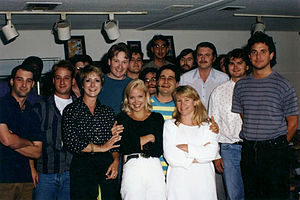
Credited with sixty episodes, John Swartzwelder is the most prolific writer on The Simpsons.[49] One of the best-known former writers is Conan O'Brien, who contributed to several episodes in the early 1990s before replacing David Letterman as host of the talk show Late Night.[50] English comedian Ricky Gervais wrote the episode "Homer Simpson, This Is Your Wife", becoming the first celebrity both to write and guest star in the same episode.[51] Seth Rogen and Evan Goldberg, writers of the film Superbad, wrote the episode "Homer the Whopper", with Rogen voicing a character in it.[52]
At the end of 2007, the writers of The Simpsons went on strike together with the other members of the Writers Guild of America, East. The show's writers had joined the guild in 1998.[53]
In May 2023, the writers of The Simpsons went on strike together with the other members of the Writers Guild of America, East.[54][55]